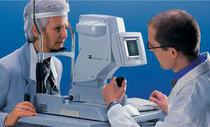
Biometry
Biometry is a test to measure the dimension of the eyeball. This include the curvature of the cornea, the length of the eyeball.
The modern biometry machine commonly uses laser interferometry technology to measure the length of the eyeball with very high precision. However, some very mature cataract can be difficult to measure with this machine, a more traditional A-scan ultrasound method may need to be used.
How to perform the test?
The test is performed with the patient resting his/her chin on the chin-rest of the machine. They are required to look at an target light and keep their heads very still. The test only take 5 minutes to complete. However, in patients with more mature cataracts, more measurements must be taken to ensure accuracy, hence the test may take longer than usual to perform.
In patients with very mature cataracts, the patients will need to undergo another test with using an ultrasound scan probe gently touching the front of the eyes for a few seconds.
How to calculate the lens implant power?
The data from the biometry results are fed into a few lens implant power calculation forumlae. The commonest formulae including the SRK-T, Hoffer-Q, and the Hagis.
The results will be assessed by the surgeons to decide on the artificial lens power that can produce the target refraction (glasses prescription) after the operation.
Do I need to wear glasses after a cataract operation?
In most cataract operation, the surgeons will aim to achieve for patients to focus at distance (emmetropia). Therefore, most patient should be able to walk about or even drive without the need of glasses. Standard lens implant cannot change the focus, so patients will need to wear reading glasses for reading. Unless the patient opt for an multifocal lens implant.
Some patients may want to keep being short-sighted, therefore reading without the need of glasses but wear glasses for distance. Some patients may even want to keep one eye focus for distance and one eye focus for near. These options must be discussed with the surgeons before surgery, so that an agreement can be reached on the desire resulting refraction.
Patients with significant astigmatism (the eye ball is oval shape rather than a perfect round shape) before the operation may still need to wear glasses for distance and near after the cataract operation, as routine cataract operation and standard lens implant do not correct the astigmatism. However, some surgeons may perform special incision technique (limbal relaxing incision) during surgery to reduce the amount of astigmatism or even inserting a toric lens implant to correct some high degree astigmatism. This must be discussed with the surgeons before surgery so that special lens implant can be ordered.
How accurate is the biometry test?
The modern technique of biometr especially with the laser interferometry method is very accurate. Patients can expect more than 90% chance to achieve within 1 diopter of the target refraction.
However, some patients with very long eyeball (very short-sighted) or very short eyeball (very long-sighted), the accuracy is a lot lower. Patients should expect some residual refraction error that will require glasses for both distance and near to see very clear.



